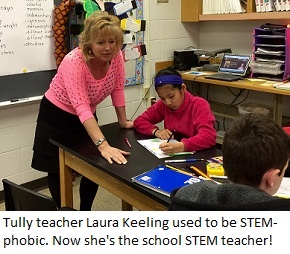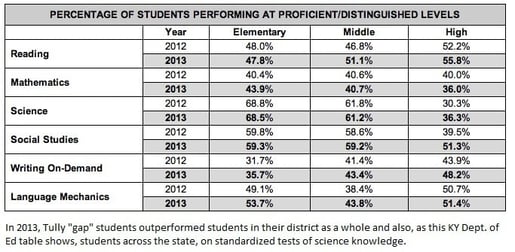 The State of Kentucky only recently put programs in place to close the “achievement gap” for minority, low-income, and English Language Learner students. Which means, this goal didn’t exist when the educators at Tully Elementary, a Jefferson County school in suburban Louisville, first started to implement the Engineering is Elementary curriculum five years ago.
The State of Kentucky only recently put programs in place to close the “achievement gap” for minority, low-income, and English Language Learner students. Which means, this goal didn’t exist when the educators at Tully Elementary, a Jefferson County school in suburban Louisville, first started to implement the Engineering is Elementary curriculum five years ago.
In the meantime Kentucky has also adopted a new assessment system. And Tully educators have been delighted to see how adding elementary engineering to the curriculum is already making a difference for what they call their “gap kids.”
Starting Small: A Teacher Gets Hooked on Engineering
The story starts in 2009, when Gary Rivoli, director of outreach programs at the University of Louisville’s school of engineering, first approached Tully's then-principal John Ansman. He invited the school to participate in a long-term project designed to get kids interested in engineering at an early age; the hoped-for outcome was that students would eventually go on to study engineering at the college.
 Laura Keeling, then a third-grade teacher at Tully, recalls attending a meeting about the initiative. “They asked, ‘Would anyone be interested in teaching this curriculum that’s supposed to get kids interested in engineering?’’ she says. “We teachers were literally sitting on our hands, we were that intimidated!”
Laura Keeling, then a third-grade teacher at Tully, recalls attending a meeting about the initiative. “They asked, ‘Would anyone be interested in teaching this curriculum that’s supposed to get kids interested in engineering?’’ she says. “We teachers were literally sitting on our hands, we were that intimidated!”
The curriculum was EiE, and Keeling felt especially intimidated. “At the time I was team teaching with another 3rd grade teacher,” she says, “and I used to BEG her to teach the science so I could teach social studies! I was NOT scientific. I didn’t have great science grades in high school, I wasn’t interested in science during college . . . but since no one volunteered, my hand went slowly to the ceiling. I can’t say why.”
Once she taught her first EiE unit, though, Keeling was hooked. “When our science lab teacher retired that year, I applied for the job. I thought, ‘If I can do engineering with one class, surely I can do engineering with all twenty-nine classes at the school!’” she says.
Building to School-wide EiE
She started small, teaching just one unit to one grade, but kept building her program; since the 2011-2012 school year, every one of the nearly 700 students in grades K – 5 engages with the hands-on engineering activities at least two EiE units each year; 4th and 5th graders learn with three units; and over the course of their academic careers, Tully students are exposed to almost all 20 EiE units . . . and the diverse fields of engineering they cover.
In the same year that Tully implemented EiE school-wide, the state legislature enacted a new assessment program, the Kentucky Performance Rating for Educational Progress, or K-PREP.
Kids Who Engineer Outscore the District Average in Science
In the past, both EiE researchers and outside evaluators have found that kids learn science better when they learn with EiE . . . and that’s what Tully is seeing today, but especially with the roughly 35 percent of the school population who are considered gap kids.
“When the first scores came back, one of the biggest ‘A-ha’s!’ was that our "gap" students did much better in science compared to other schools in the district,” says Tully's current principal, Linda Dauenhauer. Jefferson County Public Schools is the largest school district in Kentucky; in 2011 – 2012, about 55 percent of Tully students identified as "gap" scored “proficient” or “distinguished” in science, compared to just 45 percent in the district as a whole.
That trend has continued; in 2013 – 2014, for example, 73 percent of these students scored “proficient” or “distinguished” in science, compared to 54 percent in the district as a whole and 68.5 percent statewide.

High Scores, and More!
It’s more than just test scores, of course. Like every principal, Dauenhauer regularly does classroom “walk-throughs.” “It’s so nice when teachers tap me on the shoulder and point out a child who has been super quiet in the classroom before, or not really engaged, who’s now highly engaged with the engineering activities,” she says.
 “I think schools unfortunately have stripped so much creativity out kids’ hands, we are forced to, there is so much ‘required’ work to be done,” she continues. “But EiE allows kids to exercise that creativity. Kids may walk into PE thinking, ‘I can’t run fast,’ they may walk into art class thinking, ‘I can only draw stick people,” but when they walk into our STEM lab, you see smiles on their faces, and you know they are thinking, “I can be a successful engineer!”
“I think schools unfortunately have stripped so much creativity out kids’ hands, we are forced to, there is so much ‘required’ work to be done,” she continues. “But EiE allows kids to exercise that creativity. Kids may walk into PE thinking, ‘I can’t run fast,’ they may walk into art class thinking, ‘I can only draw stick people,” but when they walk into our STEM lab, you see smiles on their faces, and you know they are thinking, “I can be a successful engineer!”
The 2014-2015 test scores will be released soon, and Dauenhauer expects the trend of high (and improving) test scores to continue. “I credit the way EiE engages students in higher-order learning,” she says. “Now other principals in our district and surrounding counties are reaching out to learn more about what we’re doing with EiE.”
Dauenhauer notes that, before the school implemented EiE, teachers did facilitate some hands-on STEM activities. “But nowhere near as engaging as what we are currently doing!” she says. “And EiE fits perfectly with the new Next Generation Science Standards [NGSS],” which Kentucky adopted in 2013 . . . the second state in the nation to do so. “So EiE has helped us to be ahead of the curve with NGSS,” she says.
Bringing Hands-on Engineering to More KY Schools
Meanwhile, Keeling’s new-found passion for engineering has moved her to take on another new role she could not previously have imagined for herself: She’s become qualified as an EiE professional development provider who offers workshops to other districts. “I can’t believe how teaching EiE has transformed my passion for teaching in general,” she says.
Among the workshops she’s taught so far, Keeling has already assisted nearby Bullitt, Carroll, and Jessamyn counties with district wide EiE implementations and led a roundtable discussion on classroom engineering at a leadership conference for school superintendents.
“I think that now that engineering is part of NGSS, a lot of people are scratching their heads, asking, ‘How do we introduce this?’” she says. “I think EiE is the answer to reaching the standards, and the testimony is really in the kids.”
Engineering is Elementary is a project of the National Center for Technological Literacy® at the Museum of Science, Boston.








